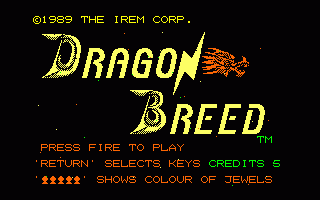Dragon Breed for Amstrad CPC
Amstrad CPCGame controls in browser
Show Controller & SystemClick on play Amstrad CPC game now button first to start emulator and load the game. Controls:
Dragon Breed
Online version of Dragon Breed for Amstrad CPC. Dragon Breed (Doragon Burīdo) is a horizontally scrolling shooter video game produced by Irem and released in arcades in 1989. It runs on M72 and M81 hardware. Activision released home computer ports in 1990. The player controls King Kayus, who rides a large dragon named Bahamoot. Bahamoot is immune to enemy attacks, capable of blocking most projectiles and damaging enemies on contact; Kayus, however, is not, but is armed with a forward-firing crossbow. Bahamoot's body is flexible and responds to Kayus' movement, enabling Kayus to use Bahamoot as a mobile shield or as a whip-like weapon. The player can also circle the tail around a group of enemies to kill them. The tail of the yellow or blue dragon can be coiled around the player to offer almost complete invulnerability for a limited time...
Game details
Other platforms online 2
You can play Dragon Breed online also in a versions for75%
rating (1 users voted)
Covers - Box Art
Amstrad CPC Computers
Online emulated version of Dragon Breed was originally developed for the Amstrad CPC (Colour Personal Computer), a series of 8-bit home computers produced by Amstrad between 1984 and 1990. It was designed to compete in the mid-1980s home computer market dominated by the Commodore 64 and the Sinclair ZX Spectrum in Europe. The series spawned a total of six distinct models: The CPC464, CPC664, and CPC6128 were highly successful competitors in the European home computer market. The later 464plus and 6128plus, intended to prolong the system's lifecycle with hardware updates, were considerably less successful, as was the attempt to repackage the plus hardware into a game console as the GX4000.
The CPC models' hardware is based on the Zilog Z80A CPU, complemented with either 64 or 128 KB of RAM. Their computer-in-a-keyboard design prominently features
an integrated storage device, either a compact cassette deck or 3 inch floppy disk drive. The main units were only sold bundled with either a colour,
green-screen or monochrome monitor that doubles as the main unit's power supply. Three built-in display resolutions are available:
160×200 pixels with 16 colours, 320×200 pixels with 4 colours, and 640×200 pixels with 2 colours.
The CPC uses the General Instrument AY-3-8912 sound chip, providing three channels, each configurable to generate square waves, white noise or both.
Additionally, a wide range of first and third-party hardware extensions such as external disk drives, printers, and memory extensions, was available.




